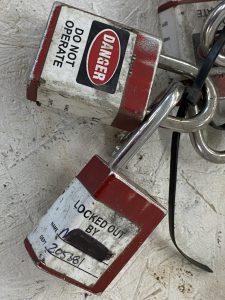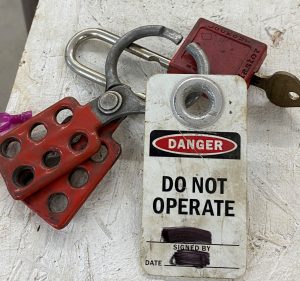3 Lock Out-Tag Out
Lock Out Tag Out is one of the most important safety aspects you will follow and receive training on. Depending on what region you are in or which state, you may have slightly different rules, but they all have the same goal in mind, keeping you safe.
OSHA will always set the standard and that will be the minimum requirements, your employer may enforce rules that are stricter than OSHA but can never impose rules less imposing.
This section will be an overview of what you can expect to encounter when working with lock-out tag-out. This will give you a head start on future training. This is no substitute for more specific training, and these are my views and opinions, and reading this does not certify you in any way.
There are many levels of Lock-Out Tag-Out, some of which are very complicated involving several layers of locks and overview, and some very simple involving no locks. Remember again, each facility may have its own set of rules and they can vary from site to site but all rules must meet the OSHA minimum to help keep you safe.
Why use LOTO (lockout tag out)? Before OSHA, work in the industrial trades was a little like the wild west. Not that anyone was looking to get hurt or did not care if anyone got hurt but, we do not know what we do not know. Through the unforeseen events that have gotten people hurt and even killed, rules and standards have been established to keep you safe.
Before the use of lockout tag-out, It was not uncommon to work on equipment without shutting off the power. At times, you would simply ask the operator of that equipment to not turn it on or to not start it because you were going to be working on it. As you can imagine, that could be problematic. If the operator forgets someone is working, or if there is a shift change when another operator comes in and they have no idea that work is being done, they could inadvertently start that equipment and potentially hurt or kill someone. Using lockout tag-out assures that the equipment you are working on. Is at a zero-energy state. A zero-energy state. Assures that that equipment cannot start, it cannot run, it cannot move. You can work on that equipment without fear of getting hurt from that equipment.
Do not just think of lockout tag-out as something that only applies to equipment that is run with electricity. When we talk about a zero-energy state, there are other types of energy that you need to be concerned with, and we will touch on a few of those.
Energy sources include electrical, mechanical, hydraulic, pneumatic, chemical, thermal, and one that you do not really think about gravity.
So, let us give an example. A stand-up mixer, one that you would mix cake batter in. In the pulp and paper industry, they have equipment like that that you could probably fit a car or truck into. Both mixers essentially do the same thing that is just on different scales, one very large one is very small. What if you go to change the mixer paddle on your stand mixer? You will probably shut the mixer off and hopefully, you would unplug it so that way you do not inadvertently turn it on. This is a simple form of lockout. You unplug it. You have control. Nobody can come up and turn that on while you are standing there.
Now let us think about the big mixture of the pulp and paper manufacturing faclilty. This mixer is very large, large enough to fit a car inside of it. This mixer probably has complicated controls, not just an on-off switch. It may also have several pipes that feed product into this bowl or tub that is going to be mixed. If you go to work inside this mixer, it is going to take more than just unplugging the motor. This is when lockouts can become complicated and confusing.
To help minimize some of the confusion OSHA requires Written procedures for these types of lockouts. These written procedures could be very long, but they are very valuable tools to keep you safe.
Aside from written procedures, the two other items that you will use during lockout tag-out are the locks and the tags. It is vitally important that you understand that you need to stay in control of your lock. each person has a key for their locks and no one else shall have access to those locks. This helps ensure that no one can have an impact on your safety. The tags on the locks should also identify by who owns the lock and tag as well as the date and the time that the lock was applied and some type of contact information so if they need to get ahold of you, they know how to.
It is also vitally important the Personnel authorized to use lockout tag-out are trained for lockout tag-out. This training should be documented and should be updated annually and reviewed.
There are sometimes where you can work on equipment that will not require you to apply a lock. We spoke of one example earlier on the mixer in your kitchen. Similar examples would be changing out a grinding disc or changing out a drill bit to where you can unplug, and you have exclusive control over that device. There could also be times when you are adjusting moving equipment that had to be done while the equipment is moving. For instances like those, there should be written procedures for how that task is completed.
You should also be aware that when a lock is applied to a piece of equipment and no matter the type of energy source, you are locking out you should always confirm that equipment will not move. This is commonly referred to as a “test start” or “trial start.” This confirms that the equipment that you have placed a lock on is in a safe state. If you try to run it, it will not run. You may have tried to move it, lower, or raise it and it does not move. This should always be done just to confirm that the equipment was locked out correctly and will not move or operate.
Only when your work is complete will you remove your lock. you are the only one that can remove me or lock me. There are certain instances when you are locking me removed by someone else but those are very rare and there is lengthy documentation and procedures to follow that are not typically done. Before removing your lock be sure that the equipment is back like it should and no tools or other equipment is left inside.
Here are two examples of tags and locks. Your company may have specific rules but most require that the user’s name and contact info or department are listed. Sometimes tags are labeled with employee pictures as well.


This is a mental checklist I use before I go to work on locked-out equipment. This is not a substitute for a lock-out procedure, just something I use to make sure I am prepared for the work at hand.
| Basic Check-List for Lock -Out Tag Out |
| This is a basic list I use to be sure I am ready to work on locked-out equipment. It is a mental checklist I go over in my head to be sure I am “good-to-go” |
| What equipment is being worked on? |
| Do I know the equipment number and location of the lockout? |
| Do I have enough locks and tags? |
| Are my tag legible with personal info? |
| What type of energy am I dealing with? Mechanical, gravity, electrical, etc.… |
| Do I need any other permits for this work or special PPE? |
| Are my tools ready and safe for use? |
| Do I know the timeline for work? |
| Who is my contact should an issue arise? |
| Who are my work partners and are they ready to go? |
Throughout your career, you are going to receive several hours of specified lockout tag-out training. As mentioned before, OSHA sets the minimum standards and each facility must meet those minimum standards, but they can also make more stringent rules and standards for their facility. There is a certain amount of trust you need to have in your bosses and managers and supervisors. But you should always feel free to question, especially regarding safety. Lockout tag-out should be taken very seriously, and you need to treat all the equipment you are working on with respect.
Common terms used when working with Lockout-Tagout:
Lockout-The means of locking a source of energy to a zero state where that energy connect be released.
Tag-The means which the identification of who is locked out on the device.
Lockout Device-Hardware of tooling that aid in the ability to apply a lock to a source of energy.
Energy Source-This is what is being controlled and can be electrical, hydraulic, pneumatic, chemical, thermal, or gravitational among others.
Trial/Test Start-This is a way to verify the equipment that has been turned off and locked will in fact not start. It is a way to very you have locked the correct equipment and it will not move or start if tried.
Lock-A lock is a keyed device in which there is only one key for the person that “owns” the lock can control.
Lock Out Procedure-This is a written document that identifies what is being locked out and lists all points that need to “locked” in order to achieve a zero-entry state.
Zero-Energy-There is no energy available and all energy has been isolated, removed, or captures where it cannot be released
You will encounter many levels of Lock-Out/Tag-Out throughout your career. Although different companies put different emphases on safety, YOU are the one that is in charge of your own safety. You need to feel 100% safe when working on equipment and YOU should always treat every piece of equipment with the same respect. No matter how large or small. An improperly locked-out piece of equipment can be deadly.
